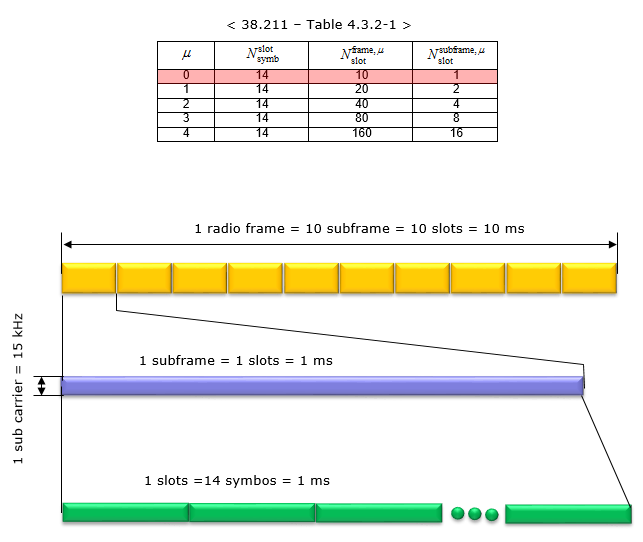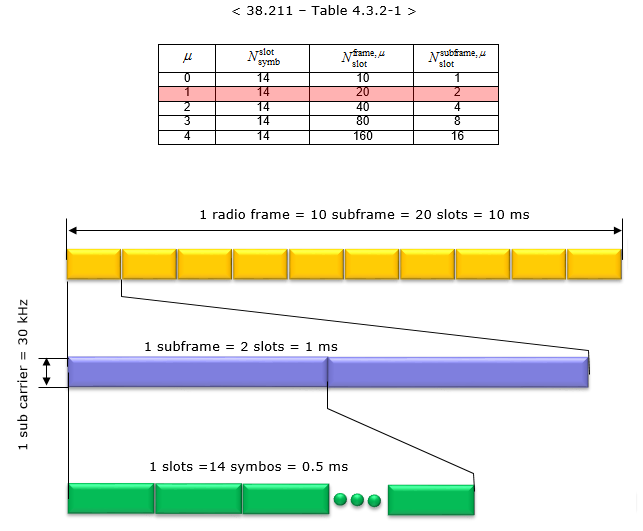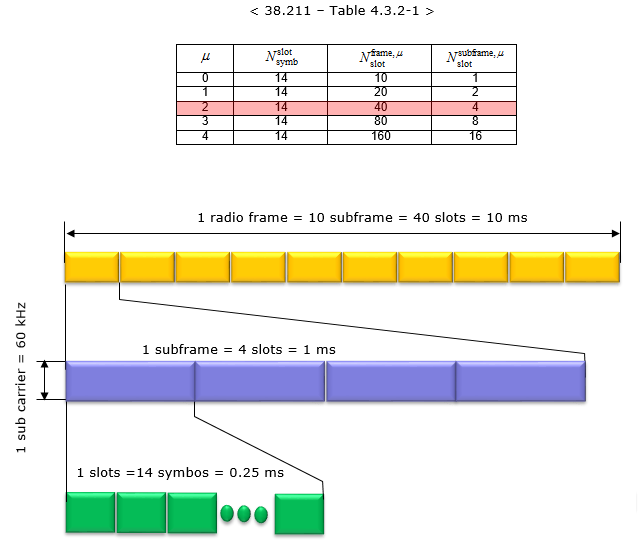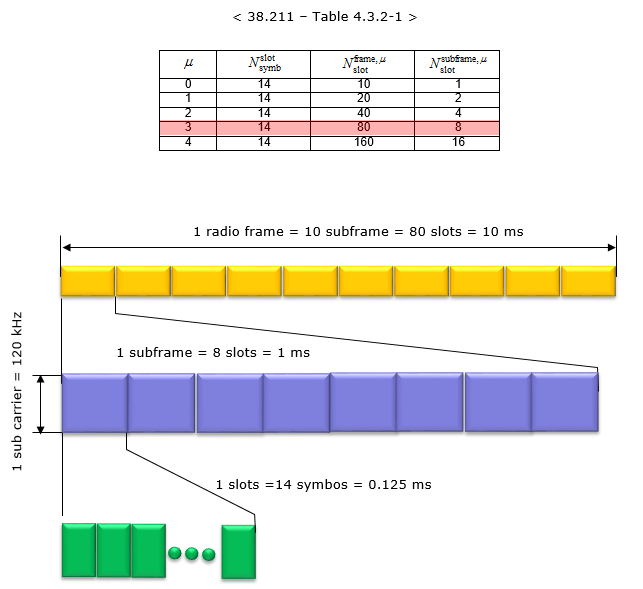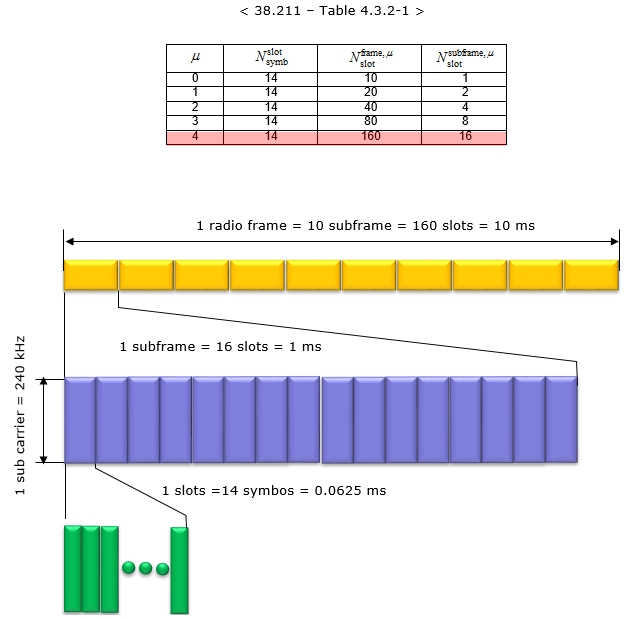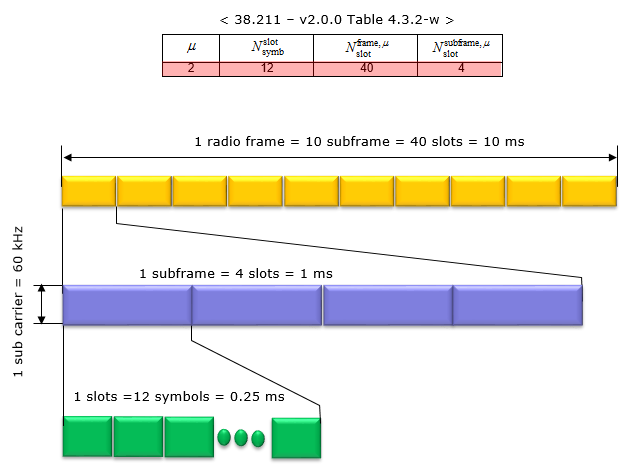UE 5G NR Search Space:
In this article, we will describe search space types viz. Type0, Type0A,
Type1, Type2, Type3, and UE specific search space sets as defined in 5G NR
standards. It mentions fields used in the Search Space information element (IE)
used by the RRC layer.
Introduction:
=>It is similar to the LTE search space.
=>It is the area in the downlink frame where PDCCH might be transmitted.
=>This area has been monitored by the UE to search for the PDCCH carrying data (i.e. DCI).
=>There are two types of search spaces viz. common and UE-specific. These are mentioned in the following table.
=>It is similar to the LTE search space.
=>It is the area in the downlink frame where PDCCH might be transmitted.
=>This area has been monitored by the UE to search for the PDCCH carrying data (i.e. DCI).
=>There are two types of search spaces viz. common and UE-specific. These are mentioned in the following table.
5G NR Search Space
Types
|
Description
|
Type0
|
PDCCH common search space set configured by
searchSpaceZero in MasterInformationBlock or by searchSpaceSIB1 in
PDCCH-ConfigCommon for a DCI format with CRC scrambled by a SI-RNTI on a
primary cell
|
Type0A
|
PDCCH common search space set configured by
searchSpace-OSI in PDCCH-ConfigCommon for a DCI format with CRC scrambled by
a SI-RNTI on a primary cell
|
Type1
|
PDCCH common search space set configured by
ra-SearchSpace in PDCCH-ConfigCommon for a DCI format with CRC scrambled by a
RA-RNTI, or a TC-RNTI on a primary cell
|
Type2
|
PDCCH common search space set configured by
pagingSearchSpace in PDCCH-ConfigCommon for a DCI format with CRC scrambled
by a P-RNTI on a primary cell
|
Type3
|
PDCCH common search space set configured by
SearchSpace in PDCCH-Config with searchSpaceType = common for DCI formats
with CRC scrambled by INT-RNTI, or SFI-RNTI, or TPC-PUSCH-RNTI, or
TPC-PUCCH-RNTI, or TPC-SRS-RNTI and, only for the primary cell, C-RNTI, or CS-RNTI(s)
|
UE specific search
space
|
This set configured by SearchSpace in
PDCCH-Config with searchSpaceType = ue-Specific for DCI formats with CRC
scrambled by C-RNTI, or CS-RNTI(s).
|
Search Space Information Element (IE)
Following structure mentions various fields used by RRC
Search Space Information Element (IE).
=> This IE defines how and where to search for PDCCH candidates.
=> Each search space is associated with one ControlResourceSet.
=> This IE defines how and where to search for PDCCH candidates.
=> Each search space is associated with one ControlResourceSet.
RRC parameters:
searchSpaceId: Identity of the search space. SearchSpaceId = 0 identifies the SearchSpace configured via PBCH (MIB) or ServingCellConfigCommon. The searchSpaceId is unique among the BWPs of a Serving Cell
Value 0 identifies the common CORESET configured in MIB and in ServingCellConfigCommon
Values 1..maxNrofControlResourceSets-1 identify CORESETs configured by dedicated signalling
monitoringSlotPeriodicityAndOffset: Slots for PDCCH Monitoring configured as periodicity and offset. Corresponds to L1 parameters 'Monitoring-periodicity-PDCCH-slot' and 'Monitoring-offset-PDCCH-slot'. For example, if the value is sl1, it means that UE should monitor the SearchSpace at every slot. if the value is sl4, it means that UE should monitor the SearchSpace in every fourth slot.
monitoringSymbolsWithinSlot : Symbols for PDCCH monitoring in the slots configured for PDCCH monitoring (see monitoringSlotPeriodicityAndOffset).The most significant (left) bit represents the first OFDM in a slot. The least significant (right) bit represents the last symbol. Corresponds to the L1 parameter 'Monitoring-symbols-PDCCH-within-slot'. This indicates the starting OFDM symbols that UE should search for a search space. For example, if the value is '1000000000000', it means that UE should start searching from the first OFDM symbol. if the value is '0100000000000', it means that UE should start searching from the second OFDM symbol.
nrofCandidates: Number of PDCCH candidates per aggregation level. Corresponds to L1 parameter 'Aggregation-level-1' to 'Aggregation-level-8'. The number of candidates and aggregation levels configured here applies to all formats unless a particular value is specified or a format-specific value is provided (see inside search space type)
search space type : Indicates whether this is a common search space (present) or a UE specific search space as well as DCI formats to monitor for
common: Configures this search space as common search space (CSS) and DCI formats to monitor.
dci-Format0-0-AndFormat1-0: If configured, the UE monitors the DCI formats 0_0 and 1_0 with CRC scrambled by C-RNTI, CS-RNTI (if configured), SP-CSI-RNTI (if configured), RA-RNTI, TC-RNTI, P-RNTI, SI-RNTI
dci-Format2-0: If configured, UE monitors the DCI format format 2_0 with CRC scrambled by SFI-RNTI
nrofCandidates-SFI : The number of PDCCH candidates specifically for format 2-0 for the configured aggregation level. If an aggregation level is absent, the UE does not search for any candidates with that aggregation level. Corresponds to L1 parameters 'SFI-Num-PDCCH-cand' and 'SFI-Aggregation-Level'
dci-Format2-1 : If configured, UE monitors the DCI format format 2_1 with CRC scrambled by INT-RNTI
dci-Format2-2 : If configured, UE monitors the DCI format 2_2 with CRC scrambled by TPC-PUSCH-RNTI or TPC-PUCCH-RNTI
dci-Format2-3 : If configured, UE monitors the DCI format 2_3 with CRC scrambled by TPC-SRS-RNTI
ue-Specific : Configures this search space as UE specific search space (USS). The UE monitors the DCI format with CRC scrambled by C-RNTI, CS-RNTI (if configured), TC-RNTI (if a certain condition is met), and SP-CSI-RNTI (if configured)





